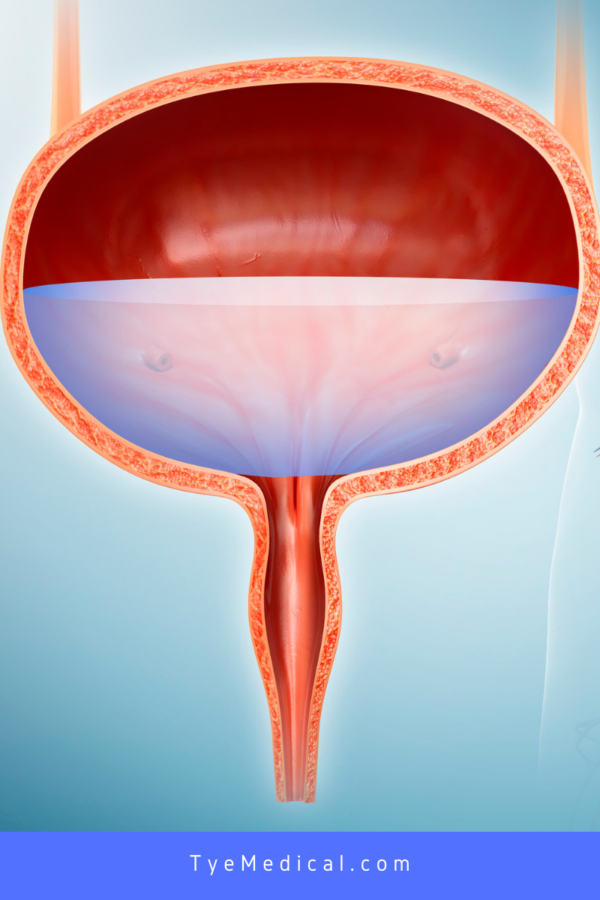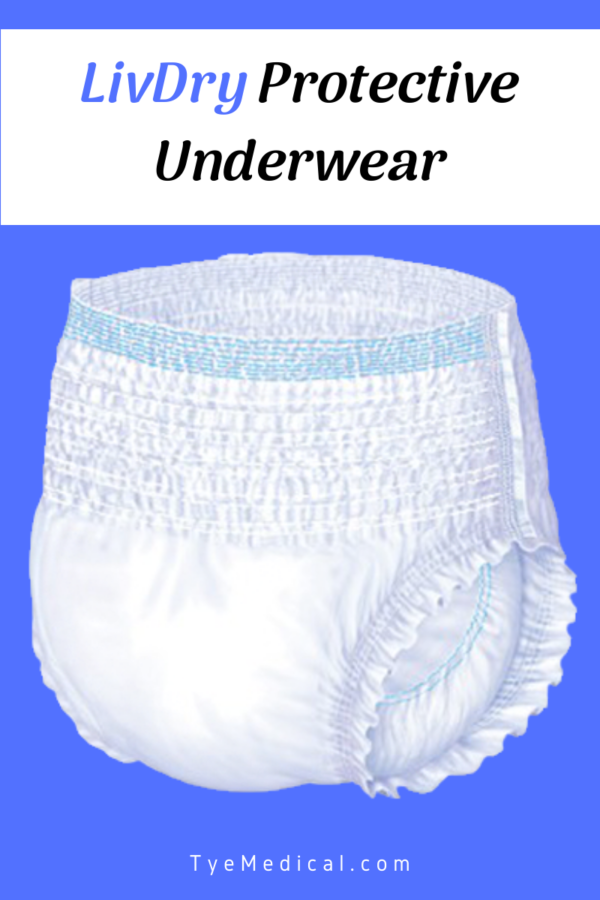Overflow Incontinence Treatment: What to Do About This Common Male Bladder Condition
Dec 3rd 2020
Until you or your loved one started having bladder leaks, you probably had no idea there were so many different types of incontinence. When it comes to treatment options, it’s important to understand the specifics of your condition, so that you can work with your doctor to determine what works best for you. In this article, we’ll dive into overflow incontinence treatment and what causes the condition in the first place. For information on other types of male incontinence, check out our article Everything You Want to Know About Male Incontinence.
Although women are far more likely to experience urinary incontinence in general, men are more likely to have overflow incontinence. Typically, enlarged prostate causes bladder problems in men, but this is just one of several causes.
When dealing with this type of incontinence, it’s important to understand the symptoms, causes, and approaches to treatment. Advice that helps one type of incontinence could aggravate symptoms in another type. Be sure to follow up with your doctor or urologist for a more certain diagnosis. If it turns out incontinence products are appropriate, our guide for men is a great place to start understanding your options.
 What Is Overflow Incontinence?
What Is Overflow Incontinence?
When your bladder doesn’t empty properly, it tends to get too full too quickly. Many times, you might not even feel the urge to go. Before you realize what’s happening – you begin leaking urine from an overfull bladder.
Every time you fail to empty your bladder, residual urine remains, taking up space. So when additional urine enters your bladder, the remaining space fills quickly. Then you’re heading to the bathroom again – and likely not emptying. The cycle continues, and problems are further complicated by frequent bladder leaks, often described as drips or dribbles.
Depending on how much urine and how concentrated it is – you might not even notice the bladder leaks.
What Are the Symptoms?
It’s best to seek overflow incontinence treatment before your symptoms become unmanageable. So pay attention to what you’re experiencing– or better yet – track them in a bladder journal (no, we’re not kidding). We’ll discuss these journals later, but for now, just stay open to taking notes on what’s happening and when. It will give both you and your doctor a fuller picture, which helps with a diagnosis.
Common overflow incontinence symptoms include:
- More trips to the bathroom
- Decreased urine flow (weak and slow)
- Difficulty starting urine flow
- A urine stream that starts and stops during urination
- Feeling fullness or pressure in the bladder even after you go
- Frequent urinary tract infections
- Leaking urine (frequency varies – also called “dribbling”)
- Getting up to urinate more than once on most nights
You might not have all these symptoms but identifying which symptoms you have will further help with a diagnosis.
What Causes Overflow Incontinence?
This type of incontinence stems from a bladder that doesn’t properly empty. Incomplete emptying is referred to as chronic urinary retention (CUR) when it’s an ongoing condition.
The constant holding of urine in the bladder – because you’re not emptying – weakens these muscles over time. Therefore, your bladder muscles aren’t squeezing forcefully enough to expel all the urine they need to expel.
Weakened bladder muscles also mean you can’t hold urine for as long and must go more frequently. The constant presence of urine in the bladder can lead to bladder infections, a common symptom of overflow incontinence.
But the question remains – what makes someone retain urine in the first place?
Enlarged Prostate in Men
Obstructions are the most common causes of overflow incontinence and CUR. For male overflow incontinence, an enlarged prostate (BPH) is the usual suspect. For more details about BPH, prostate surgery, and incontinence, check out our article Everything You Need to Know About Incontinence After Prostate Surgery.
A man’s prostate sits right beneath the bladder and the urethra runs from the bladder through the prostate. So when it’s enlarged due to age or other reasons, it presses on the urethra enough to block urine flow to varying degrees.
When an enlarged prostate causes urinary problems, you experience increased frequency and urgency. This makes you feel like you must go right now and that you must go more often.
But when you try to go, you experience some of the symptoms listed above. It’s difficult or impossible to get started, the flow starts and stops, urine flow is weak, and you don’t empty.
Other Causes in Men and Women
- Nerve-related conditions like multiple sclerosis (MS), diabetes, or brain injuries (brain not signaled that you need to pee)
- Bladder stones or tumors
- Chronic constipation (bowels pressing against bladder)
- Medications
- Prior pelvic surgery (causing damaged muscles or nerves)
- Severe prolapse of bladder or uterus in women
- Prostatitis (infection of the prostate)
- Urethral stricture (narrowing due to a procedure, catheter use, prostate surgery, STD, radiation therapy)
 How Is It Diagnosed?
How Is It Diagnosed?
Unfortunately, there is no objective test that provides all the answers. Diagnosis requires a more subjective approach that considers details about your symptoms as well as various forms of testing, all of which can provide a clearer picture.
Start with a Bladder Journal
You have a lot of information to keep up with, and your doctor will ask lots of questions. The easiest and most effective way to manage this is with a bladder journal. Use a digital or paper journal, just be sure to include the following:
- How much you drink and when
- When you urinate
- How much urine you produce (approximately)
- If you felt an urge to urinate
- If you feel pain or pressure in your abdomen (how often, how severe)
- How often you leak
- How much fluid you leak (a dribble, a wet pad, or soaked through)
Yes, it seems like a pain. But try it for a week or two before your next doctor appointment. This organized information can speed up the process of getting an accurate diagnosis and overflow incontinence treatment.
Expect Diagnostic Testing
Depending on your symptoms, your doctor might start with a simple pelvic ultrasound or cystoscopy (a tiny scope that looks inside your bladder). The ultrasound helps your doctor determine how much urine remains after you empty and may indicate other problems if they exist.
For a closer look at the walls of your bladder, you might have a cystoscopy. This provides information about the health of your bladder. Is there inflammation? Cysts? Other growths or imperfections?
Additionally, you might have one or several of these tests:
- Stress test or cough test (You cough while the doctor checks for leaks.)
- Urine analysis/culture (This rules out infection, and you will probably have this one right away.)
- Prostate exam (It diagnoses an enlarged prostate in men.)
- Urodynamic test (Indicates how much urine the bladder can hold and if it empties.)
- Post-void residual measurement (Checks how much urine is left in your bladder after you think you’ve emptied. If a large amount remains – this might indicate a blockage in the urinary tract or a problem with the bladder muscles or nerves.)
 What Are Overflow Incontinence Treatment Options?
What Are Overflow Incontinence Treatment Options?
Most likely, your treatment plan will include a combination of therapies that work best for you. A bladder journal will also help you and your doctor develop a treatment plan. When you try a new treatment, record the data, and look for positive, negative, or neutral outcomes.
Does this therapy relieve your symptoms on its own? Or do two therapies work best when combined?
Record your observations and don’t be afraid to admit that something just isn’t working. Instead, move on and try something else. Just be sure you’re giving each treatment enough time to work. Your doctor can guide you in this.
Bladder Training
If (and only if) your doctor recommends it, try bladder training. If weakened muscles are the issue, then you can strengthen those muscles by learning to hold your urine for longer periods. Try holding it for ten minutes longer than you normally would. For days or weeks, work your way up to urinating every 2-4 hours. Shoot for whatever feels most comfortable to you.
Double Voiding
This is an important tool for those who have incomplete bladder emptying. Once you finish, wait a few minutes, and try again – even if you don’t feel the urge. You don’t have to stay in the bathroom. Start by waiting thirty minutes and then slowly decrease the time before you try again. This can help train your bladder to empty.
Schedule Bathroom Breaks
Also, try scheduling bathroom breaks so that you’re urinating every 2-4 hours instead of waiting until you need to go. Decide which time works best for you, and then go according to the clock – not according to your bladder. Remember, you might not be getting the signal to go when you need to, but you can head off bladder leaks and pressure if you go within a certain window of time.
Do Your Kegels
Don’t forget about Kegel exercises. Anyone with incontinence has heard about this simple workout. Whether sitting, standing, or lying down, tighten your pelvic muscles (what you squeeze to hold your pee) for 5-10 seconds, then relax for another 5-10 seconds. Do 10 reps 3 times per day. This strengthens those pelvic floor muscles that help you keep your urethral sphincter closed – making you less likely to leak urine.
Medications to Try
Depending on the severity of your symptoms, your doctor might recommend medication. Discuss these options thoroughly and ask about common side effects to help determine if the risks outweigh the benefits.
Alpha-blockers are a type of medication that relax muscle fibers in the prostate or bladder neck muscles. This aids in more complete bladder emptying.
- alfuzosin (Uroxatral)
- tamsulosin (Flomax)
- doxazosin (Cardura)
- silodosin (Rapaflo)
- terazosin
If you’re a man with an enlarged prostate, your doctor will likely treat that condition first to see how that affects your bladder problems.
Most of the above medications, including tamsulosin, are only prescribed to men. However, some medical professionals prescribe it for women – unofficially. Many women report some symptom relief, even though the medications were designed for male urinary and prostate problems.
Surgery as an Overflow Incontinence Treatment
Typically, surgery is a last resort due to the delicate nature of the urinary tract and nearby reproductive system. However, sometimes it’s necessary, especially when there is an obstruction.
Common surgical procedures include:
- Bladder neck suspension
- Sling procedures
- Prolapse surgery
- Artificial urinary sphincter
Protect Against Bladder Leaks with Our Most Popular Product
Be sure to invest in quality, comfortable, incontinence pads or underwear. They’re made to absorb urine, draw the liquid away from your skin, and neutralize odors. They’re your best defense against leaks and the problems that go with them.
We hope you’ll check out our most popular product LivDry Protective Underwear,they fit discreetly under your clothes and provide all the protection you need, including a super-absorbent gel core, cloth-like stretch panels, tear-away sides, and leakage barrier leg cuffs.
While you’re checking them out, also consider our Shaped Pads that are designed to work with the Protective Underwear. This combination allows you to replace only the leak-resistant pad with each change.


